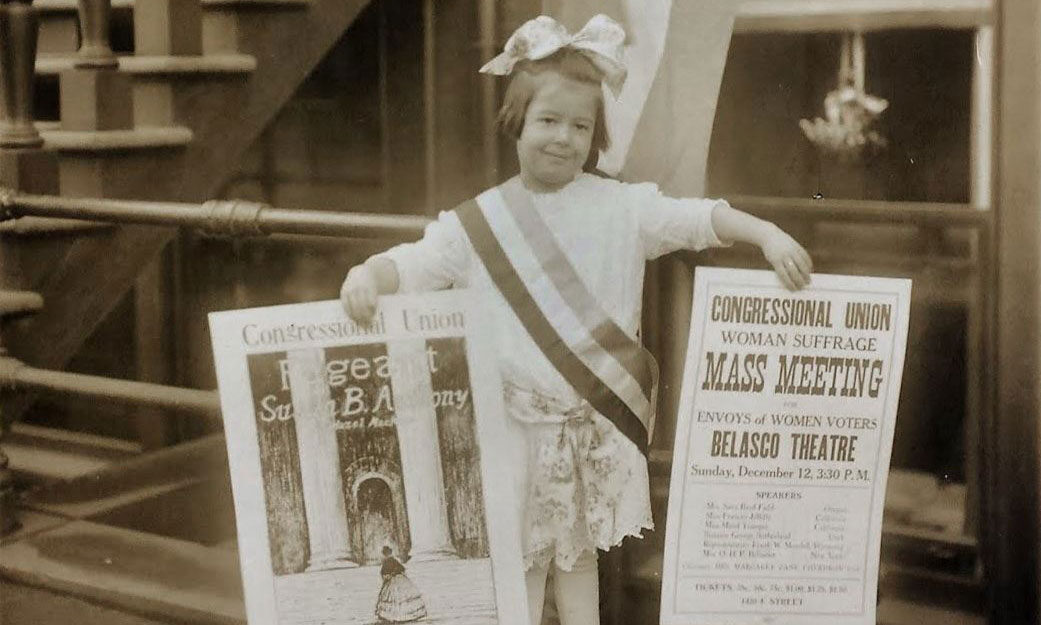And still, she persisted
Suffragist Lucia Voorhees Grimes, BA 1902/MA 1906, cracked the code of suffragism soon after she joined the movement. By 1912, as recording secretary and chairman for publicity in the Wayne County Equal Suffrage Association, this teacher by training had been shut down repeatedly by opponents who felt a woman’s place was in the home — taking care of her babies, no less.
“I am at home,” she reportedly snapped while phoning to rent a car on behalf of the association. “My housework is done, my baby has had her bath and is now asleep, and you know a woman can still talk.”
As her role in the fledgling movement grew, Grimes adopted a stealthier move to disarm her opponents. She learned to make lace. The tactic allowed her “to be able to sit in various meetings and look completely domestic even if I had to make a suffrage speech.”
An organizer by nature
Grimes was hardly domestic. As a young girl, Lucia helped run the Voorhees family farm after her father died. At the same time, she was such a good student that she was offered a teaching position before she even graduated from high school. She left smalltown Illinois to earn her bachelor’s degree and teaching certificate at U-M with a focus on English and history. She traveled to the Upper Peninsula and Oklahoma City to pursue her career.
In 1907, she married the man she met her first day in Ann Arbor, George Grimes. He was an instructor in mechanical engineering at U-M, and a foundry specialist. They settled in Detroit and George founded the Grimes Molding Machine Company, where Lucia would work as a purchasing agent. She also taught at Cass Tech High School for 20 years (1928-48) and put in considerable hours toward a doctoral degree.
Though she dabbled in the women’s movement as part of the College Suffrage League, she fully immersed in advocating for the women’s vote beginning in the 1912 election year. Michigan’s Gov. Chase Osborn had succeeded in getting the state legislature to put a suffrage amendment on the ballot and the Equal Suffrage League of Wayne County was on a mission. Grimes was chair of the league’s political department.
When Election Day came around, the women assigned themselves to various voting booths to prevent voter fraud. Grimes sensed the chairman at her booth was dismayed when she arrived. According to an article at the Historical Society of Michigan, Grimes described the man as being “somewhat disturbed” and needing to “balance himself by putting his hand on the wall.”
Card carrier
The suffragists were defeated that year, and the next. Grimes knew the movement needed a new strategy to break the stalemate. She created an index card filing system that tracked each member of the Michigan legislature. In addition to recording each politician’s view on suffrage, Grimes’ fellow activists made note of personal details about each legislator: their family status, religion, health, and hobbies. The cards served as valuable tools while lobbying lawmakers and provided salient talking points. Patterns began to emerge and the suffragists acted accordingly. For example, if a politician voted according to opinion in his home district, the league might schedule a rally to show that the district was in favor of suffrage.
“You had to know who you knew,” Grimes was known to say.
Her methodology came to be known as “the pressure system,” and was so effective it attracted national attention. In the fall of 1915, Alice Paul, leader of the National Women’s Party, invited Grimes to Washington, D.C., to establish a national card system that could be customized to track the voting behavior and attitudes of members of the U.S. Congress. Grimes traveled to the capital with her five-year-old daughter Emily in tow. (Emily eventually would attend U-M too, earning a degree in journalism.)
Grimes spent five weeks in Washington completing her system. During that time, Emily was photographed holding posters promoting a Susan B. Anthony pageant. The image (above, courtesy of U-M’s Bentley Historical Library) was published in newspapers nationwide.
The National Women’s Party maintained Grimes’ card catalog for four years until Congress passed the 19th Amendment, which was ratified Aug. 18, 1920. The “pressure system” is credited with being a powerful influence in helping to pass women’s suffrage. In fact, Michigan was one of the first three states to ratify it on June 10, 1919.
That same year, Grimes began a six-year term as Detroit School Inspector. She remained a staunch and active advocate of women’s rights throughout her life. In 1920, in recognition of her contribution to the suffrage movement, she was elected chairman of the Legislative Council of Michigan Women. She served as recording secretary of the Campaign League of Detroit and was founder and president of the Wayne County Republican Women’s Club, where she held a leadership role for five decades.
Grimes passed away in 1978. She was inducted into the Michigan Women’s Hall of Fame in 1995.
Sources: The Bentley Historical Library, the Historical Society of Michigan, Michigan Women Forward, and ‘Her Hat Was in the Ring.’




Ann Harris Hunnewell - 1958, 1963?
Do you have a photo of Lucia making lace?
Do you realize how seldom you called her “Lucia”?
Reply
Deborah Holdship
I wish I had a photo of her making lace! And normally I would only have called her Lucia on first reference, but with a husband and daughter also called Grimes in the story, I had to distinguish her here and there. She sounds like she was a thoroughly modern woman! What a pretty name too.
Reply
Martha Payne - 1967
Very interesting. I will post this in the Reacting to the Past FB faculty Lounge for those who run the Greenwich Village game.
Reply
Eleanor Satlow - 1970
Loved reading about this inspiring woman, noted that she taught at Cass Tech in Detroit until 1948, the school I graduated from in 1966.
Reply